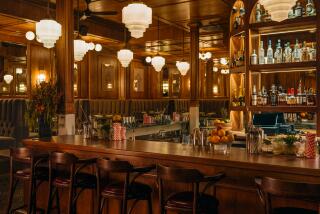A genuine Mr. Coffee
- Share via
Love coffee? Hate the burnt beans at Starbucks? Or has Starbucks spoiled you for anything else? Do you shun any coffee except what you brew at home, from the beans you buy from a local roaster and grind yourself?
If the answer to any of these questions is yes, you’re part of the legacy of Alfred Peet, who died on Aug. 29 at 87. More than anyone else, Peet created today’s coffee culture.
Before Peet opened his Berkeley coffee shop in 1966, coffee in this country was an on-off proposition -- something you drank without thinking, which was generally a wise strategy. Until Peet set off the gourmet revolution, American coffee was pretty bad, if not the “lousiest coffee” in the world, as Peet, whose father had run a small roasting business in the Netherlands, called it soon after immigrating in 1955.
It hadn’t always been that way. Even before the founding of the United States, when colonists infuriated by the British-imposed tea tax -- and perhaps attracted by coffee’s association even then with rebellion -- began drinking coffee in earnest, Americans had bought perfectly decent arabica beans, the high-growing, slow-ripening, high-flavor kind. Only after World War II did robusta beans -- the low-growing, low-flavor, cheap and woody ones -- invade U.S. blends, as supermarkets used canned coffee as a loss leader and returning veterans accustomed to cheap, Army-issued coffee thought robusta beans were just fine.
Peet brought a new kind of connoisseurship to a place that was ready to embrace it: the radicalized community of Berkeley, where rejecting stale, conformist coffee could be viewed on a continuum with rejecting stale, conformist war policies. Alice Waters may be rightly credited with launching the American food revolution, and with it the buy-local movement, from her restaurant Chez Panisse, which opened in 1971 around the corner from the original Peet’s. But Waters herself credits Peet with making her and her customers take a hard look at who grew and made what they were eating and drinking -- including wine.
The generation of coffee men (and some women) who changed the U.S. industry trained directly with Peet -- most lastingly the three founders of Starbucks, who bought all their roasted coffee beans from Peet’s for the first two years they ran their Seattle store. One of them, Jerry Baldwin (who brought in current Chairman Howard Schultz, the man who made Starbucks global), eventually bought Peet’s and upheld the founder’s exacting standards alongside Peet’s roaster, Jim Reynolds. The Starbucks founders’ decision to make dark roasts their standard and to emphasize blends over single-origin coffees (beans from one country or plantation) gave rise to the style that consumers all over the world now think of as sophisticated.
But others in the same generation came away with lessons every new connoisseur should still learn. Smell the beans before you grind them, and smell them green -- unroasted -- if you can. Learn the building blocks of every blend by sampling coffee from Central and South America, Africa and Indonesia. Pay attention to each flavor you taste in each sip of brewed coffee (no milk, no sugar). Then hit on the kind you like, blend or single-origin, and buy from a roaster who adjusts offerings with the coffee-harvesting seasons.
The one day I spent with Peet, after he had retired and devoted his time to training the post-Starbucks generation, I experienced the preliminary steps of what coffee trader Tim Castle had promised would be “sensory yoga.” After several hours we had gone no further than smelling several kinds of green beans. Peet, an exacting and decisive man, took things at the pace he wanted.
One of Peet’s lessons has been, I believe, lost: Learn to appreciate light roasts. Peet didn’t have much use for these, but that didn’t mean he thought they were for rubes. After all, the countries that long led the world in buying the finest quality beans, Germany and Sweden, still roast beans light; so, often, does Japan, which currently buys the best beans. Sacrificing mouth-filling body for delicacy and a tingling sparkle is often the sign of great coffee. George Howell, a member of the original Peet’s generation, hunts for this benign form of “acidity” at his Terroir Coffee, which he opened in 2004, 10 years after selling his Boston-based Coffee Connection to Starbucks during Schultz’s first wave of national expansion.
That one man’s preferences could shape international taste is extraordinary. Peet’s legacy persists in the hundreds of personalized drinks people order from Starbucks baristas every second everywhere in the known world, and on the blogs like sweetmarias.com that unite coffee fanatics in many countries. Anyone who considers his or her own taste in coffee to be the only right taste is making Alfred Peet, somewhere, smile.
More to Read
Eat your way across L.A.
Get our weekly Tasting Notes newsletter for reviews, news and more.
You may occasionally receive promotional content from the Los Angeles Times.










